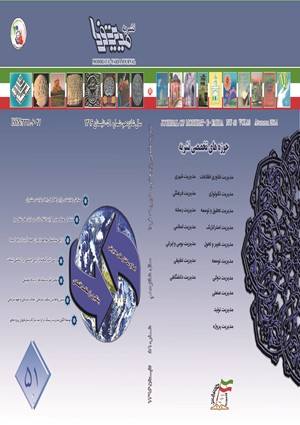استراتژی مسیریابی و زمان بندی بهینه وسایل امدادی برای تخلیه افراد سالم در شرایط بحران
محورهای موضوعی :مهدی حیدری 1 , فاطمه صبوحی 2 , علی بزرگی امیری 3
1 - دانشگاه علم و صنعت ایران
2 - دانشگاه علم و صنعت ایران
3 - دانشکده مهندسی صنایع، پردیس دانشکده های فنی، دانشگاه تهران
کلید واژه: مسیریابی زمان بندی پناهگاه فاجعه امدادرسانی,
چکیده مقاله :
هر ساله وقوع بلایای طبیعی مانند زلزله، سونامی، طوفان و .. سبب بی خانمان شدن هزاران نفر، ایجاد خسارت های قابل توجه اجتماعی، اقتصادی و حتی باعث مرگ تعداد زیادی از افراد می شود. پس از وقوع فاجعه یکی از مهم ترین اقدامات حیاتی، تخلیه ی افراد سالم از مناطق حادثهدیده به پناهگاه ها است. در این مقاله یک مدل برنامه ریزی ریاضی خطی عدد صحیح مختلط برای مسیریابی و زمان بندی وسایل امدادی ارائه شده است. که امکان خدمت دهی به افراد سالم در هر منطقه ی حادثهدیده توسط چندین وسیله، امکان خدمت گرفتن از هر پناهگاه توسط چندین وسیله، وجود چندین مرکز بحران، محدودیت تعداد و ظرفیت وسایل، محدودیت ظرفیت پناهگاه ها و محدودیت پنجره های زمانی برای رسیدن وسایل به هر نقطه ی حادثهدیده و به هر پناهگاه در نظر گرفته شده است. در این مدل ریاضی، هدف کمینه سازی کل زمان رسیدن وسایل امدادی به نقاط حادثهدیده و پناهگاه ها است.
Each year natural disasters such as earthquake, tsunamis, hurricanes, etc. due to the thousands of people homeless, cause a significant loss of social, economic and even cause the death of many people. One of the most critical steps after the disaster is to evacuate healthy victims to shelters from disaster areas. We propose a mixed integer linear mathematical programming model to provide the routing and scheduling of relief vehicles with possibility of servicing to healthy people in the each disaster area by several relief vehicles, the possibility of getting service from the each shelter by several relief vehicles, several crisis centers, the number and capacity constraint for each vehicle, capacity constraint for each shelter and time windows constraint to get to relief vehicles to disaster areas and shelters. The objective of the model is to minimize total time to get to relief vehicles to the disaster areas and shelters.
[1] A. R. Akkihal, "Inventory pre-positioning for humanitarian operations," Massachusetts Institute of Technology, 2006.
[2] K. Eshghi and R. C. Larson, "Disasters: lessons from the past 105 years," Disaster Prevention and Management: An International Journal, vol. 17, pp. 62-82, 2008.
[3] S. U. Ngueveu, C. Prins, and R. W. Calvo, "An effective memetic algorithm for the cumulative capacitated vehicle routing problem," Computers & Operations Research, vol. 37, pp. 1877-1885, 2010.
[4] D. R. Bish, "Planning for a bus-based evacuation," OR spectrum, vol. 33, pp. 629-654, 2011.
[5] H. Abdelgawad and B. Abdulhai, "Large-scale evacuation using subway and bus transit: approach and application in city of Toronto," Journal of Transportation Engineering, vol. 138, pp. 1215-1232, 2011.
[6] M. Hamedi, A. Haghani, and S. Yang, "Reliable transportation of humanitarian supplies in disaster response: model and heuristic," Procedia-Social and Behavioral Sciences, vol. 54, pp. 1205-1219, 2012.
[7] G. M. Ribeiro and G. Laporte, "An adaptive large neighborhood search heuristic for the cumulative capacitated vehicle routing problem," Computers & Operations Research, vol. 39, pp. 728-735, 2012.
[8] S. Wohlgemuth, R. Oloruntoba, and U. Clausen, "Dynamic vehicle routing with anticipation in disaster relief," Socio-Economic Planning Sciences, vol. 46, pp. 261-271, 2012.
[9] F. Wex, G. Schryen, and D. Neumann, "Operational emergency response under informational uncertainty: a fuzzy optimization model for scheduling and allocating rescue units," 2012.
[10] X. Gan, Y. Wang, Y. Yu, and B. Niu, "An emergency vehicle scheduling problem with time utility based on particle swarm optimization," in Proceedings of the 9th international conference on Intelligent Computing Theories and Technology, 2013, pp. 614-623.
[11] L. Ke and Z. Feng, "A two-phase metaheuristic for the cumulative capacitated vehicle routing problem," Computers & Operations Research, vol. 40, pp. 633-638, 2013.
[12] F. B. Ozsoydan and A. Sipahioglu, "Heuristic solution approaches for the cumulative capacitated vehicle routing problem," Optimization, vol. 62, pp. 1321-1340, 2013.
[13] K. Lee, L. Lei, M. Pinedo, and S. Wang, "Operations scheduling with multiple resources and transportation considerations," International Journal of Production Research, vol. 51, pp. 7071-7090, 2013.
[14] K. Lee, L. Lei, and H. Dong, "A Solvable Case of Emergency Supply Chain Scheduling Problem with Multi-stage Lead Times," Journal of Supply Chain and Operations Management, vol. 11, p. 30, 2013.
[15] A. Pramudita, E. Taniguchi, and A. G. Qureshi, "Location and Routing Problems of Debris Collection Operation after Disasters with Realistic Case Study," Procedia-Social and Behavioral Sciences, vol. 125, pp. 445-458, 2014.
[16] L. Özdamar, D. T. Aksu, and B. Ergüneş, "Coordinating debris cleanup operations in post disaster road networks," Socio-Economic Planning Sciences, vol. 48, pp. 249-262, 2014.
[17] X. Gan, Y. Wang, J. Kuang, Y. Yu, and B. Niu, "Emergency Vehicle Scheduling Problem with Time Utility in Disasters," Mathematical Problems in Engineering, 2014.
[18] F. Wex, G. Schryen, S. Feuerriegel, and D. Neumann, "Emergency response in natural disaster management: Allocation and scheduling of rescue units," European Journal of Operational Research, vol. 235, pp. 697-708, 2014.


